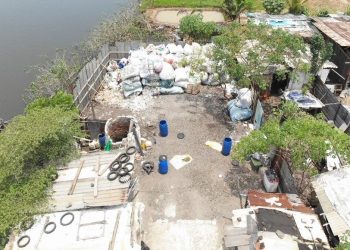Jakarta, Indonesia Sentinel — Indonesia is entering the peak of its rainy season, marked by a sharp increase in rainfall across much of the country, according to the Meteorology, Climatology, and Geophysics Agency (BMKG). The agency warned the public to stay alert for potential disasters triggered by extreme weather events.
BMKG chief Teuku Faisal Fathani issued the warning during the National Disaster Preparedness Assembly organized by the Ministry of Public Works on Tuesday (November 4), a day after he was officially appointed as the agency’s new head, replacing Dwikorita Karnawati.
Faisal said rainfall levels over the past three months have risen significantly, with many areas now experiencing medium to high rainfall intensity. He also noted that a weak La Niña phenomenon has emerged in Indonesian waters ahead of the rainy season’s peak and is expected to persist until March 2026.
“The weak La Niña will last until early 2026. While its impact on rainfall increase is not expected to be too significant, high precipitation during this period must still be closely monitored,” Faisal said in an official statement.
BMKG forecasts heavy to very heavy rainfall across southern Indonesia including Java, Bali, West and East Nusa Tenggara, South Sulawesi, and southern Papua. From February to April 2026, rainfall in most areas is expected to return to moderate and near-normal levels.
Between November and December 2025, however, many regions will continue to experience above-normal rainfall, particularly in northern Sumatra, northern Kalimantan, northern Sulawesi, and North Maluku.
The agency said atmospheric conditions remain unstable, favoring the formation of convective clouds due to a combination of global and regional factors such as the weak La Niña and a negative Dipole Mode (-1.61). This combination increases the likelihood of heavy rainfall and strong winds in several provinces, including North Sumatra, West Java, Central Java, Yogyakarta, East Java, Banten, West Nusa Tenggara, and South Sulawesi.
BMKG also detected Tropical Cyclone Kalmaegi in the southwest of Lampung over the Indian Ocean, along with several other systems influencing national weather patterns.
Read Also:
Indonesia Economy Expands 5.04% in Q3 2025, Driven by Manufacturing and Household Spending
Minister of Public Works Dody Hanggodo emphasized the importance of preparedness among all government bodies to anticipate potential hydrometeorological disasters.
“BMKG has warned that rainfall intensity will increase significantly in many regions, raising the risk of flooding and landslides,” Dody said. “It’s crucial that all government agencies, at both national and regional levels, strengthen mitigation efforts and readiness.”
He added that disaster preparedness is not merely a matter of information but a shared responsibility requiring collaboration between central and local governments, the military, police, and local communities.
(Raidi/Agung)


























